Resemblance to nature, naturalism and Transcendental Painting
Is naturalism and a resemblance to nature the same?
Is figurative painting necessarily naturalistic?
Is abstract painting the sole alternative to naturalism?
The works shown in the right column are examples of naturalism in painting.
Is figurative painting necessarily naturalistic?
Is abstract painting the sole alternative to naturalism?
The works shown in the right column are examples of naturalism in painting.
Naturalism and the Transcendental Painting
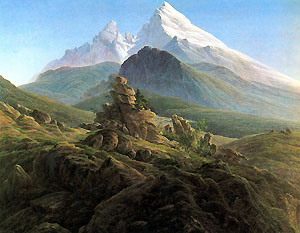 Naturalism represents the exterior properties in its portrayal of the model, which can be a real object or an imagined reality. For improved delimitation and for the general clarification of the concepts, Vietinghoff used the term "naturalism" strictly for works copied from nature. Such works may achieve technically masterful results but do not include any transcendent experience, as the artistic imagination does not participate. Therefore, naturalistic works appear sterile, cool and "inanimate". According to Vietinghoff, naturalism is absolute nonart and as far away from his defined Transcendental Painting as abstract painting. Both naturalist and abstract painters represent extremes: the former depends on the visible reality and the latter leaves it completely.
Naturalism represents the exterior properties in its portrayal of the model, which can be a real object or an imagined reality. For improved delimitation and for the general clarification of the concepts, Vietinghoff used the term "naturalism" strictly for works copied from nature. Such works may achieve technically masterful results but do not include any transcendent experience, as the artistic imagination does not participate. Therefore, naturalistic works appear sterile, cool and "inanimate". According to Vietinghoff, naturalism is absolute nonart and as far away from his defined Transcendental Painting as abstract painting. Both naturalist and abstract painters represent extremes: the former depends on the visible reality and the latter leaves it completely. 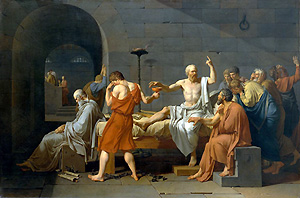 Pure naturalism and abstract painting are the two opposing poles in the spectrum of possible artistic expression. Naturalism is a rudimentary copy without imagination and creates "etudes" of workmanship or technical masterpieces based on meticulous observation. Thus, the missing spirit is replaced with compulsive imitation. An absolute, yet undeserved, importance is given to the world of physical appearance. The view of inner truth is confused with the external reality. In naturalism, the visible details are zealously juxtaposed rather than in a performance of spiritual artistic experience.
Pure naturalism and abstract painting are the two opposing poles in the spectrum of possible artistic expression. Naturalism is a rudimentary copy without imagination and creates "etudes" of workmanship or technical masterpieces based on meticulous observation. Thus, the missing spirit is replaced with compulsive imitation. An absolute, yet undeserved, importance is given to the world of physical appearance. The view of inner truth is confused with the external reality. In naturalism, the visible details are zealously juxtaposed rather than in a performance of spiritual artistic experience.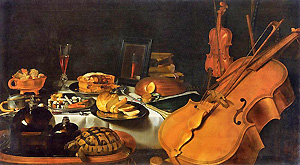 The naturalist believes to act as an artist is to collect knowledge of the subject and display it on the canvas. The animal painter shows his zoological knowledge, the landscape painter his skills in perspective, the sculptor or painter of nudes his anatomic expertise, the painter of battle scenes his discernment of uniforms and weapons. In the eyes of the followers of naturalism, the aim of any artistic creation is fulfilled if the representation corresponds to reality. On the other hand, opponents of naturalism suspect any similarity to nature to be a consequence of the lack of creative power or the artist’s inability to distance himself from out-dated conventions.
The naturalist believes to act as an artist is to collect knowledge of the subject and display it on the canvas. The animal painter shows his zoological knowledge, the landscape painter his skills in perspective, the sculptor or painter of nudes his anatomic expertise, the painter of battle scenes his discernment of uniforms and weapons. In the eyes of the followers of naturalism, the aim of any artistic creation is fulfilled if the representation corresponds to reality. On the other hand, opponents of naturalism suspect any similarity to nature to be a consequence of the lack of creative power or the artist’s inability to distance himself from out-dated conventions. 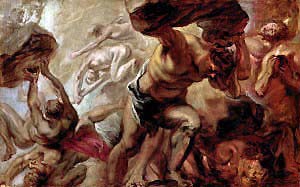 A painter who creates in the form of the Transcendental Painting shows on the canvas the plays of colors, forms and lights which the subject produces in his mind's eye. However, the naturalist paints what the optic of his physical eye registers. The former penetrates the world and comprehends it from the inside; the view of the latter hits only the surface of the object. Naturalism is to "Transcendental Painting" as a documentary is to poetry, or an anatomic view of men to a philosophical view. Thus, naturalism is not a style but appears in the works of artists lacking imagination in every period. "When imagination wanes, naturalism begins", Vietinghoff said. Naturalism is a sign of a lack of inspiration and even great artists do not experience inspiration continuously and sometimes even their works may flatten into naturalistic images.
A painter who creates in the form of the Transcendental Painting shows on the canvas the plays of colors, forms and lights which the subject produces in his mind's eye. However, the naturalist paints what the optic of his physical eye registers. The former penetrates the world and comprehends it from the inside; the view of the latter hits only the surface of the object. Naturalism is to "Transcendental Painting" as a documentary is to poetry, or an anatomic view of men to a philosophical view. Thus, naturalism is not a style but appears in the works of artists lacking imagination in every period. "When imagination wanes, naturalism begins", Vietinghoff said. Naturalism is a sign of a lack of inspiration and even great artists do not experience inspiration continuously and sometimes even their works may flatten into naturalistic images. Abstract and Transcendental Painting
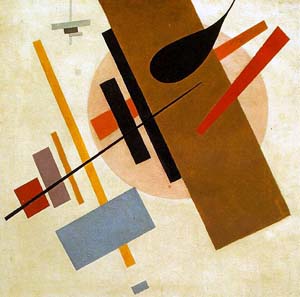 Abstract painting and naturalism are diametrically opposite. The ultimate abstract painting has nothing to do with the natural perception. However, this cannot be the pretended inevitable and true alternative to naturalism.
Abstract painting and naturalism are diametrically opposite. The ultimate abstract painting has nothing to do with the natural perception. However, this cannot be the pretended inevitable and true alternative to naturalism. According to Egon von Vietinghoff, abstract painting is an absurdity because isolated colors do not express something generally intelligible and abstract forms belong to the genre of decorative (ornamental) art. Certain colors and forms may have a symbolic meaning on which society agrees, such as red ~ "love" or "stop", green ~ "hope" or "go", circle ~ "absoluteness", "abundance" or "emptiness", infinity sign [∞] "endless" or "married". But abstractions, symbols, signs, hieroglyphs and pictograms are not always understood depending on the culture and time and have different connotations in other contexts.
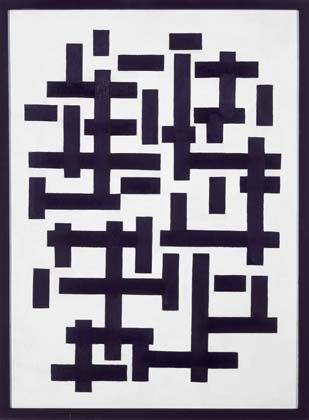 Abstract paintings may depend on the aesthetic feeling (taste), the will to stylize and structure, certain thoughts and reflections or even pure chance. Just as naturalistic works, they miss the transcendent experience as Vietinghoff formulated. Naturalism and abstraction constitute a logical pair of opposites, but remain on a different level from the Transcendental Painting.
Abstract paintings may depend on the aesthetic feeling (taste), the will to stylize and structure, certain thoughts and reflections or even pure chance. Just as naturalistic works, they miss the transcendent experience as Vietinghoff formulated. Naturalism and abstraction constitute a logical pair of opposites, but remain on a different level from the Transcendental Painting.In his manuscript "The Nature of Visual Arts", Vietinghoff shows why colors cannot be placed in a systematic order with absolute definite positions and with the possibility to be reproduced as sounds on a scale. Theories of colors seek parallels between colors and sounds which is interesting yet unsatisfying. The analogy must fail, because sounds, which are readable by notes, develop in the one dimensionality of time and colors extend on the bi-dimensional canvas. Thus, colors do not represent a generally intelligible language and need always be attached to a figurative shape to be unambiguously comprehended.
According to Vietinghoff, abstract works are intellectual constructions or games depending on the zeitgeist. Thus, they are as "empty" as the naturalistic ones. Both of them are missing the spiritual and mystic penetration of the sensual world which occurs during the artistic transformation which – in his eyes – is necessarily a transcendental experience as the precondition of true art. From this point of view, only a few painters and sculptors, who followed and continue to do so along the path of abstraction, are credible. Other kinds of modern art of the twentieth century, Vietinghoff considered to be rebellious protests, capricious experiments, helpless wanderings in search of new kinds of expression, and self-representations addicted to publicity or simply mocking the public.
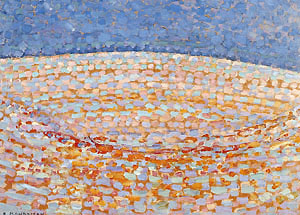 Naturalism is figurative but not every figurative work is naturalistic. Just as an abstract painting is not an inspired piece of art due to its radical distance to copying naturalism. At the first view, abstract paintings became more estranged from its "enemy" naturalism than from figurative and transcendental paintings. In certain periods of some painters (such as the studies of trees and dunes of Piet Mondrian), we recognize the common endeavor of Egon von Vietinghoff and his contemporaries to dissolve the objects in pure color parts. The pictures of the abstracts became gradually cooler and plainer (prime example the work of Mondrian); whereas Vietinghoff's paintings show more and more warmth and plasticity.
Naturalism is figurative but not every figurative work is naturalistic. Just as an abstract painting is not an inspired piece of art due to its radical distance to copying naturalism. At the first view, abstract paintings became more estranged from its "enemy" naturalism than from figurative and transcendental paintings. In certain periods of some painters (such as the studies of trees and dunes of Piet Mondrian), we recognize the common endeavor of Egon von Vietinghoff and his contemporaries to dissolve the objects in pure color parts. The pictures of the abstracts became gradually cooler and plainer (prime example the work of Mondrian); whereas Vietinghoff's paintings show more and more warmth and plasticity. Representationalism (realism), Resemblance to Nature and Transcendental Painting
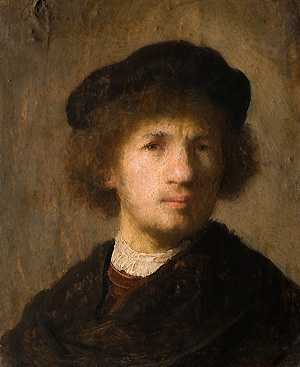 On the one hand, innumerable examples of paintings from Bosch, Rembrandt and Goya, to Corot, Gauguin and Kokoschka show that realism (representationalism, figurative art) does not necessarily lead to naturalism.
On the one hand, innumerable examples of paintings from Bosch, Rembrandt and Goya, to Corot, Gauguin and Kokoschka show that realism (representationalism, figurative art) does not necessarily lead to naturalism. On the other hand, Turner impressively proved that colors gradually dissolve from the subject during the transformation in transcendental painting without ending in a deliberately constructed abstraction.
For better distinction between "representational paintings" (with either natural resemblance or transcendental creation) and "representational but naturalistic" ones, Vietinghoff distinguished between optical and transcendental perception and, therefore, between optical and transcendental resemblance to nature.
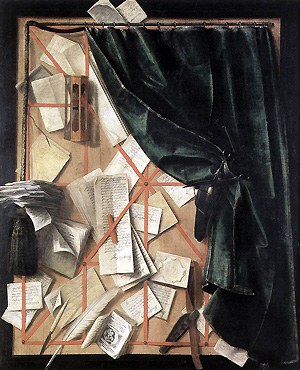 "Resemblance to nature" means oriented on the object or united with the object but not "identically copied" from nature. The representation is a result of transcendental perception that looks life-like and is not only a correct reproduction of its formal characteristics. The transcendental painter looks "beyond" the objects or "through" them; he is not attached to their description but detaches himself from their visible forms. However, not every kind of detachment, as used in abstract painting, automatically guarantees a work of art.
"Resemblance to nature" means oriented on the object or united with the object but not "identically copied" from nature. The representation is a result of transcendental perception that looks life-like and is not only a correct reproduction of its formal characteristics. The transcendental painter looks "beyond" the objects or "through" them; he is not attached to their description but detaches himself from their visible forms. However, not every kind of detachment, as used in abstract painting, automatically guarantees a work of art.The alternatives of "either representational or abstract" is a false polarization and misses the essential point of visual arts. The transcendental painting offers another way to show the relation between the physical and the transcendental side of the world.
The "optical resemblance" to nature is solely oriented to the visible world and portrays the objects in their external appearance. The aim of this art is fulfilled if the painter achieves a remarkable copy, although it is bi-dimensional. Vietinghoff considered this to be only skillful or even artificial art, similar to a sleight of hand to amaze the public (trompe-l'oeil effect = trick of the eye). This is a substitute of nature similar to an artificial perfume which is confusingly close to the original one. Such pictures may serve as decoration for empty walls but they do not nourish a mind which is hungry for a deeper experience of art, similar to fast food lacking nutrition.
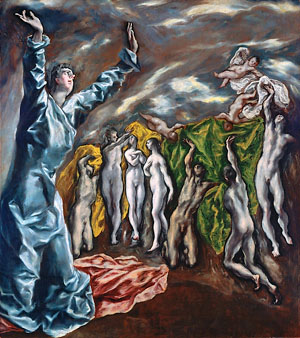 The "transcendental resemblance" is not blindly oriented to the measurable properties of the phenomena, because it is not based on the observation of reality and its intention is not imitation. Its objective is to transmit an irrational, mystic experience. Thus, "trueness to life" does not request a precise copy of the surfaces, which is both technically impressive and industrious but an uninspired piece of work.
The "transcendental resemblance" is not blindly oriented to the measurable properties of the phenomena, because it is not based on the observation of reality and its intention is not imitation. Its objective is to transmit an irrational, mystic experience. Thus, "trueness to life" does not request a precise copy of the surfaces, which is both technically impressive and industrious but an uninspired piece of work. According to Vietinghoff, to paint "true to nature" means to follow what nature offers, i.e. to let representation remain in representationalism.
The result may be more or less close to the subject depending on the painting technique and style (compare for example Giotto, Chardin, Sisley, van Gogh, Macke), and the artistic vision, the transcendental experience (compare for example Grünewald, El Greco, Rubens, and Turner).
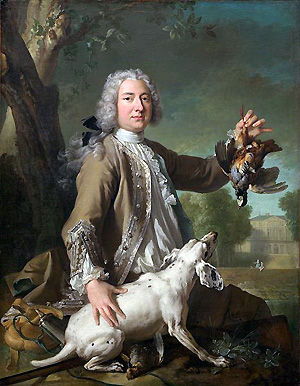 Naturalism keeps the style of prior art periods which created a resemblance to nature. Thus, there is no external difference between optical (naturalistic) and transcendental resemblance to nature. If, in addition, two contemporaries painted the same subject, most beholders would not be able to see the difference between an expert performance and a transcendental masterpiece (compare for example Canaletto and the genius Guardi or Delaporte and the genius Chardin). (Please look at the website www.vietinghoff.org the chapter "Comparisons" referring the Transcendental Painting).
Naturalism keeps the style of prior art periods which created a resemblance to nature. Thus, there is no external difference between optical (naturalistic) and transcendental resemblance to nature. If, in addition, two contemporaries painted the same subject, most beholders would not be able to see the difference between an expert performance and a transcendental masterpiece (compare for example Canaletto and the genius Guardi or Delaporte and the genius Chardin). (Please look at the website www.vietinghoff.org the chapter "Comparisons" referring the Transcendental Painting).In transcendental painting the phenomena dissolve in color parts before the mind's eye. The object as such disappears and the artistic imagination seizes the performance of forms and colors. The result of this artistic transformation, not the real object, is what we see on the canvas. Aside from the colors of the spectrum, color is always attached to a shape. As the combination of color and form serves as general intelligible language, the beholder of the colors join them easily together to the original form and he is able to understand the meaning of the color graduations and the play of light. This human ability develops from early experience, when a child learns to adapt its view to three-dimensionality.
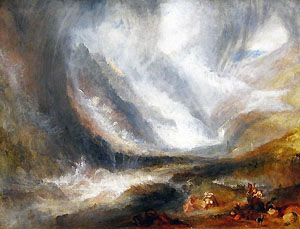 This visual phenomenon also happens if some color parts have an "abstract" effect (obviously in Turner's later paintings), due to the proximity to the subject. Even after the artistic transformation, such paintings are recognizable, even a fruit and a face are changed into highly imaginative landscapes of colors, plays of light and reflexes and rhythms of forms in the transcendental experience of the artist instead of painted documentation.
This visual phenomenon also happens if some color parts have an "abstract" effect (obviously in Turner's later paintings), due to the proximity to the subject. Even after the artistic transformation, such paintings are recognizable, even a fruit and a face are changed into highly imaginative landscapes of colors, plays of light and reflexes and rhythms of forms in the transcendental experience of the artist instead of painted documentation. This intelligibility is not given any more in abstract painting because the color is deprived of any sensual manifestation. Thus, the message needs a literary explanation – the origin language of painting is consciously abandoned.